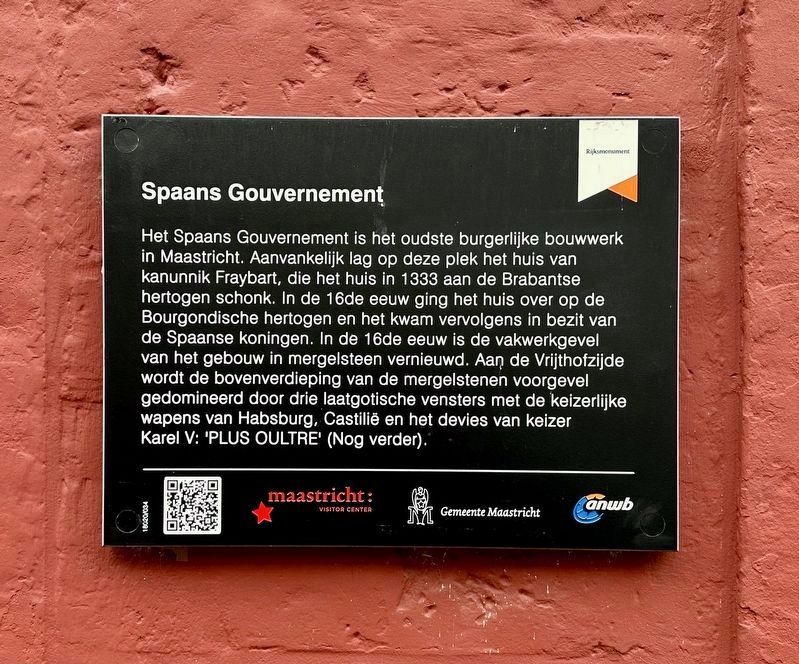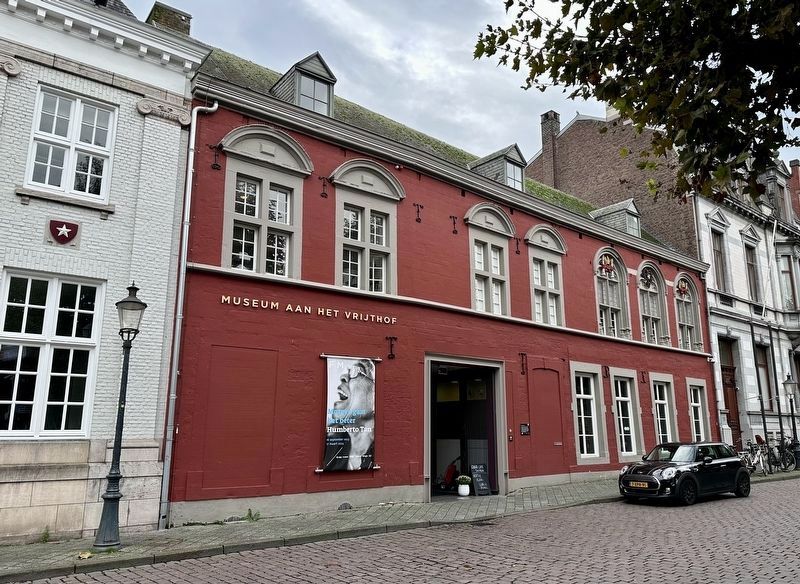Centre in Maastricht, Limburg, Netherlands — Northwestern Europe
Spaans Gouvernement / Spanish Governate
— Rijksmonument —
Inscription.
The Spanish Governorate is the oldest civil structure in Maastricht. Originally this was the house of Canon Fraybart, who in 1333 gave the house to the Duchy of Brabant. In the 16th century the house was transferred to the Burgundian dukes and it subsequently came into possession of the Spanish Crown. The half-timbered facade of the building was renovated with marlstone in the 16th century. On the Vrijthof side of the building the top floor of the marlstone facade was topped by three late Gothic windows with the imperial coats of arms of Habsburg, Castile, and the motto of the emperor Charles V: 'PLUS OULTRE' (further beyond).
Erected by maastricht: Visitor Center, Gemeente Maastricht, ANWB.
Topics. This historical marker is listed in these topic lists: Architecture • Government & Politics. A significant historical date for this entry is October 14, 1520.
Location. 50° 50.902′ N, 5° 41.337′ E. Marker is in Maastricht, Limburg. It is in Centre. Marker is on Vrijthof, on the left when traveling west. Touch for map. Marker is at or near this postal address: Vrijthof 17B, Maastricht, Limburg 6211 LD, Netherlands. Touch for directions.
Other nearby markers. At least 8 other markers are within walking distance of this marker. Sint Servaasbasiliek / Basilica of Saint Servatius (about 90 meters away, measured in a direct line); Nicolas Beaurieux (about 120 meters away); Sint Janskerk / Saint Johns Church (about 120 meters away); Bergportaal (about 150 meters away); Westwerk St. Servaasbasiliek / Westwork of the Basilica of St. Servatius (about 180 meters away); Generaalshuis / Generals House (about 180 meters away); Dominicanenkerk / Dominican Church (about 210 meters away); Sint Servaasfontein / Fountain of Saint Servatius (about 210 meters away). Touch for a list and map of all markers in Maastricht.
Also see . . .
Spaans Gouvernement (Zicht op Maastricht).
Extract: The history of the Spaans Gouvernement goes back to the start of the fourteenth century. At that time, the building belong to Johannes Fraybart, canon of the Chapel of Saint Servatius. Over the course of that century, the duchy of Brabant acquired ownership of the building, and the dukes stayed here when visiting the city.(Submitted on November 15, 2023.)
On 14 October 1520, Emperor Charles V visited Maastricht for the first time. Much fanfare heralded his arrival: the secular and spiritual elite of the city plus 4,000 marksmen brought him to the Spaans Gouvernement. On that occasion, part of the building was drastically remodelled.
A marlstone façade was added, with a stone plinth on a marl base. The first floor was given three late-Gothic round arch windows with carved coats of arms. The central window depicts the double-headed Habsburg eagle, holding the shared coat of arms of Habsburg and Castile. The other two windows are topped with the pillars of Hercules, with an imperial crown on the left and a royal crown on the right. Above these pillars is a band on which is Emperor Charles V’s motto: PLUS OULTRE. Meaning ‘further beyond’, this motto symbolizes the huge area over which he ruled at the start of the sixteenth century, stretching all the way to the Strait of Gibraltar.
Credits. This page was last revised on November 15, 2023. It was originally submitted on November 15, 2023, by Andrew Ruppenstein of Lamorinda, California. This page has been viewed 39 times since then and 9 times this year. Photos: 1, 2. submitted on November 15, 2023, by Andrew Ruppenstein of Lamorinda, California.

